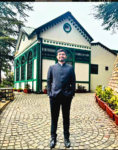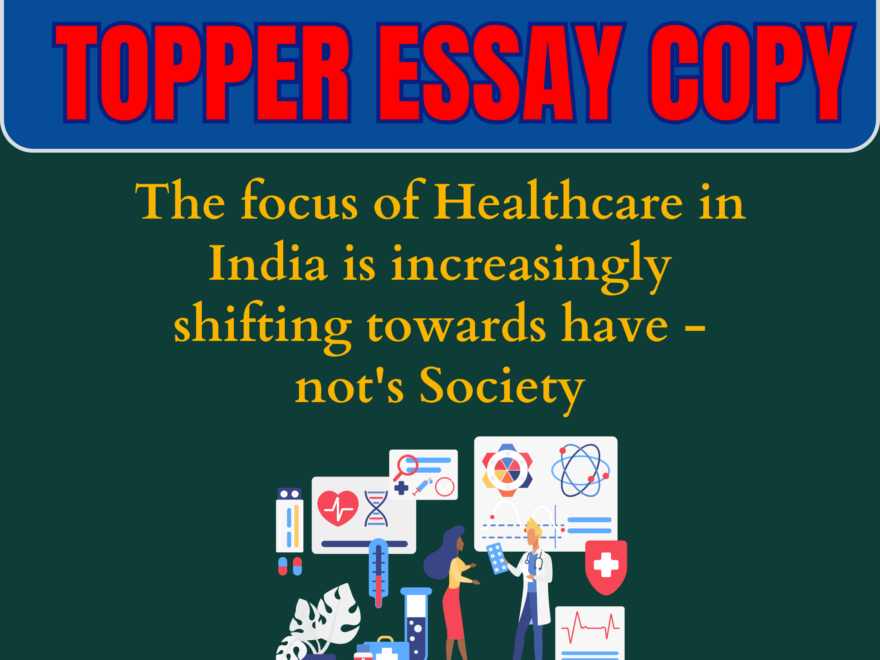IAS,PRAKHAR KUMAR SINGH

Essay topic:
The focus of Healthcare in India is increasingly shifting towards have – not’s Society.
(Relevant for Essay Writing for UPSC Civil Services Examination)
The focus of Healthcare in India is increasingly shifting towards have – not’s Society.Meena was a student of Government High School in Aara, Bihar. We could easily recognize her by her weak profile. “If you see any student studying the whole day while coughing, it would be Meena,” says her teacher. She used to top her class. But nobody paid attention to the cough she had. She died 1 year later, probably because of tuberculosis as her parents couldn’t afford treatment. There are thousands like Meena who have become victims of the lax healthcare system of India. Who knows we might have lost a teacher, a pilot, or a Nobel laureate in her. But then who is to blame? Is it because of poverty of parents, poor primary healthcare infrastructure of India, or something else. This essay will try to answer such questions. We will look into the evolution and present state of healthcare infrastructure. We will look into current measures taken to help ‘have nots’ like Meena and analyze as to whether they are enough. This essay will conclude by looking into some international best practices and how ‘India healthcare’ can be better universalized. WHO ARE HAVE-NOTS? Take the case of highly neglected ‘have nots’ i.e. tribals. Their isolation from mainstream society has reduced access to healthcare for them. Moreover, 47% STs live below the poverty line and are thus unable to afford the highly privatized healthcare facilities which translates into high MMR and IMR (Infant Mortality Rate). Similar is the case with women. It is an unwritten practice that women eat last in Indian households which has translated into malnutrition, evident in 53% being Anemic (NFHS-IV). Lacking financial independence, they are not taken to hospitals by highly patriarchal Indian society, as can be seen in high non-institutional deliveries and MMR (Maternal Mortality: 122/1 lakh). But is the deplorable condition only because of society or there are fractures in the Indian healthcare system itself? The neglect of ‘have nots’ has not been due to choice but probably a systemic issue. INDIAN HEALTHCARE SYSTEM: PINNACLE OF ASYMMETRY India lacks basic healthcare infrastructure which is the bedrock system for providing healthcare to ‘have nots’ of society. The number of beds per 1 lakh people is 70 in India compared to 420 in China. Doctor to people ratio is 1:1456 compared to WHO’S recommendation of 1:1000 which speaks volumes of scarcity of resources. The healthcare system has discriminated against the ‘have nots’ due to structural issues too. Health being a ‘state subject’ has led to incoherence in policy making at state and national levels, the latest example being chaos amidst the initial phase of COVID-19 spread. The latest National Medical Commission bill also lacks adequate state representation adding to the chaos. Medical Education in itself has become so expensive that it is seen as an ‘end in itself’ rather than as a ‘means’ for the ‘end’ of public welfare. This gets reflected in urban: Rural doctor ratio divide of 38:1 as only the ‘rich’ can afford it, leaving the ‘have nots’ in dark who reside primarily in rural areas or in shuns. Let us look at why India hence needs to make a transformative shift towards have-nots at the first place then. HEALTH IS WEALTH Healthcare has multifold impacts on other fields of living too. India’s out-of-pocket expenditure is 68% compared to UK’S 17%, thus pushing the already marginalized into deeper darkness. It churns the vicious cycle of poverty where the unhealthy are not able to learn & equip themselves with education & skills, thus only going downwards. In fact, the need for ground-based healthcare has not been felt strongly ever than amidst the COVID-19 pandemic. This has been on the minds of policymakers now for a long time and India has taken notable steps towards it. INDIAN HEALTHCARE: SHIFTING GEARS Along with it, PM Jan Aushadhi Yojna is providing generic medicines at affordable costs- a boon for the economically marginalized ‘have nots’. Integrated Child Development Services (ICDS) have taken healthcare to the doorstep thus bridging the Divide and filling the gulf between administration and citizens. Women who are at the forefront of today’s policy making have PM Matru Vandana Yojna for institutionalizing deliveries and reducing MMR rates. Mid Day Meal is further fighting the ‘devil’ of malnutrition. India’s latest announcement of National Digital Health Mission will help institutionalizing entire healthcare networks, thus opening doors of transparency and accountability for have-nots. Thus, Indian Healthcare truly seems to be shifting towards the have-nots. But All that Glitters is not Gold. The latest case of private hospitals denying ICV beds in Bihar to the poor despite government regulations against doing so, becomes a case in point of the current state of healthcare infrastructure. Thus, armed with disabilities of low insurance penetration, unaffordable healthcare, and low awareness, have-nots of India are struggling for a living, more so amidst COVID-19. UNIVERSAL HEALTHCARE: A RAY OF HOPE Cuba has successfully employed UHC. It has not only helped decrease poverty but also has improved cohesion in society. Amidst the COVID-19 shock, Cuba dealt with it with its highly decentralized system and emerged out stronger. It is now even helping other Central American countries to cope with the pandemic. The need is to inculcate Health as a ‘public Good’ in essence while drafting policies. Inspite of ‘Right to education’ being a statutory right, there is no ‘Right to Health’ as a statutory right Article 97 in Directive Principles of state Sate to give good ‘nutrition and ensure provisions of ‘public Health’. But still cases like that of meena are in thousand, speaking volumes of the current state of Health.
International collaborations like done in COVID – 19 vaccine development /Soliolarity trial) need to be expanded to larger health infrastructure. WHO’S triple billion target can serve as a connecting point and ‘Nordic Countries’ practices should be achieved at a global level and multiplied into other countries.
Novel schemes live ‘Medical social Responsibility’, mandatory posting of doctors in rural areas for initial areas can be explored for achieving SDG#3 ‘Good Health and Well Being’.
The need is to look ‘have nots’ like Meena as ‘assets of the nation’ They also have the right to a dignified living. Then only India (Asian Elephant) can emerge out as the leader of the 21st century.
Sarve bhavantu Sukhinah May all Beings be happy
Sarve Santu Niramyah May all Experience peace
Sarve Bhadrani Pashyantu May No One suffer from illness
Ma kascciduh Dukh Bhagh Bhaveta Om Peace Peace Peace
|
To master these intricacies and fare well in the Sociology Optional Syllabus, aspiring sociologists might benefit from guidance by the Best Sociology Optional Teacher and participation in the Best Sociology Optional Coaching. These avenues provide comprehensive assistance, ensuring a solid understanding of sociology’s diverse methodologies and techniques
Meta Tags:
Water Resource Management,Water Resource Management,Water Resource Management,Water Resource Management,Water Resource Management,Water Resource Management,Water Resource Management, Water Resource Management,Water Resource Management,Water Resource Management,Water Resource Management

Why Vikash Ranjan’s foundation Classes for Essay?
Proper guidance and assistance are required to learn the skill of writing essay topics in CSE examination. VIKASH RANJAN SIR at TRIUMPH IAS guides students according to the Recent Trends of UPSC, making him the Best Essay Teacher for Essay writing UPSC.
At Triumph IAS, the Best Essay Writing Coaching platform, we not only provide the best study material and applied classes of Essay for IAS but also conduct regular assignments and class tests to assess candidates’ writing skills and understanding of the subject.
Choose The Best Essay Writing Teacher for IAS Preparation and Know our Approach for Essay?
- The Programme is Planned & Executed in a Way that You Write a good Essay for obtaining Effective Score of 140 Plus.
- In this programme we provide Classes on
- How to INTRODUCE The Topic in Context of the THEME of the Essay
- How to Elaborate & Explain the Topic-Theme on Temporal Scale & Sectoral Scale as well as Intellectual Scale in the MAIN BODY of the Essay.
- How to Sum up the Topic in CONCLUSION in Context of the Essay Topic Theme.
- ︎We will Teach You How to use the Knowledge Matrix of General Studies & Optional to write a Good Essay more Logically and Coherently.
- After the Classes You have to “Write to Learn & Learn to Score” .This means You have to Write the Essay Test Papers & Learn from the Feedback & Discussions.
Why Essay is Important and What We Offer in “Essay Test Series”?
- Triumph’s Essay Upgradation Test Series (Under Personal Guidance of Vikash Ranjan Sir) doesn’t only focus on improving student’s linguistic skills but also focus on improving student’s ability to comprehend the topic-sentence (subject) recall & relate the facts, concepts, propose thesis-statements, and logically assimilate the ideas & counter ideas with clarity in expression on temporal & Sectoral Scales of knowledge.
- Further students are provided one-on-one INTERACTION* Session with Vikash Ranjan Sir. Students get personal feedback on their strength and weaknesses, regarding what is ‘good about their essay and what more should be done to make it a better one’ by Vikash Ranjan Sir.
Why to take up this “Essay Test Series and Foundation” Course?
- Essay is Low hanging Fruit. Marks in Essay is Effectively Contributing in Final Selection in New Pattern of Mains Exam. With a Well Developed ‘Knowledge Matrix and Rigorous Practice’, One can Score upto 160 + in Essay. So IAS Aspirants should never Ignore Essay Preparation
- Inculcating Writing Competency in Essay for IAS, which is Different from Essay in English, Essay in School and College.
Follow us :
🔎 https://www.instagram.com/triumphias
🔎https://www.youtube.com/c/TriumphIAS
🔎https://t.me/VikashRanjanSociology
Find More Blogs…
| Compare and contrast Karl Marx’s and Max weber’s | Karl Marx- Historical Materialism |
| Position of Women In the Modern Indian Society | Sociology: Social system and pattern variables |
keyword: Healthcare in India is increasingly shifting, Healthcare in India is increasingly shifting, Healthcare in India is increasingly shifting, Healthcare in India is increasingly shifting, Healthcare in India is increasingly shifting, Healthcare in India is increasingly shifting, Healthcare in India is increasingly shifting, Healthcare in India is increasingly shifting, Healthcare in India is increasingly shifting, Healthcare in India is increasingly shifting, Healthcare in India is increasingly shifting, Healthcare in India is increasingly shifting, Healthcare in India is increasingly shifting, Healthcare in India is increasingly shifting, Healthcare in India is increasingly shifting, Healthcare in India is increasingly shifting, Healthcare in India is increasingly shifting, Healthcare in India is increasingly shifting, Healthcare in India is increasingly shifting, Healthcare in India is increasingly shifting, Healthcare in India is increasingly shifting,

